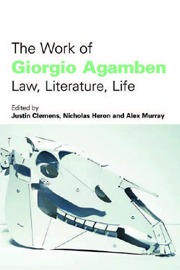Book contents
- Frontmatter
- Contents
- Acknowledgements
- Notes on Contributors
- The Enigma of Giorgio Agamben
- 1 K
- 2 Integral Actuality: On Giorgio Agamben's Idea of Prose
- 3 The Role of the Shifter and the Problem of Reference in Giorgio Agamben
- 4 ‘Its Silent Working was a Delusion’
- 5 Politics and Poetics of Divine Violence: On a Figure in Giorgio Agamben and Walter Benjamin
- 6 Idea of Poetry, Idea of Prose
- 7 The Fading Memory of Homo non Sacer
- 8 Soulblind, or On Profanation
- 9 Face to Face with Agamben; or, the Other in Love
- 10 Beyond Spectacle and the Image: the Poetics of Guy Debord and Agamben
- 11 Dismantling Theatricality: Aesthetics of Bare Life
- 12 Notes on Media and Biopolitics: ‘Notes on Gesture’
- Index
11 - Dismantling Theatricality: Aesthetics of Bare Life
Published online by Cambridge University Press: 12 September 2012
- Frontmatter
- Contents
- Acknowledgements
- Notes on Contributors
- The Enigma of Giorgio Agamben
- 1 K
- 2 Integral Actuality: On Giorgio Agamben's Idea of Prose
- 3 The Role of the Shifter and the Problem of Reference in Giorgio Agamben
- 4 ‘Its Silent Working was a Delusion’
- 5 Politics and Poetics of Divine Violence: On a Figure in Giorgio Agamben and Walter Benjamin
- 6 Idea of Poetry, Idea of Prose
- 7 The Fading Memory of Homo non Sacer
- 8 Soulblind, or On Profanation
- 9 Face to Face with Agamben; or, the Other in Love
- 10 Beyond Spectacle and the Image: the Poetics of Guy Debord and Agamben
- 11 Dismantling Theatricality: Aesthetics of Bare Life
- 12 Notes on Media and Biopolitics: ‘Notes on Gesture’
- Index
Summary
A theatre stage, bare, without setting. The boards and walls are black. All at once, men and women enter the stage, one after the other, without clear order, without rhythmic scansion. They come from nowhere, as if they were already on the stage, as if they were already part of it. Each follows his or her own movement, without paying attention to the others, whether those are persons on the stage or spectators sitting comfortably in their armchairs. These men and women are neutral bodies. Identically dressed, they wear black suits, black shoes and white shirts. They walk. One foot after another, confident, as if directed by a superior orientation, they traverse the space in multiple enjambments. Their heels strike the ground, producing a repetitive, staccato sound. They walk. Each in his or her direction, they create lines that interweave without ever encountering or colliding. There is no physical shock. The walking bodies belong to a chaotic mass whose volume is made of silent irritation. The gazes are hard, those of human beings who work, whose time is occupied by business; the circulation is fast and easy because formatted. The arms oscillate in a rigid fashion, one forward, one back, directly opposed to the diagonal line of the legs. The chests are erect, proud but inexpressive. The bodies are the walk, they are militarised. The walk is a parade.
- Type
- Chapter
- Information
- The Work of Giorgio AgambenLaw Literature Life, pp. 181 - 192Publisher: Edinburgh University PressPrint publication year: 2008



